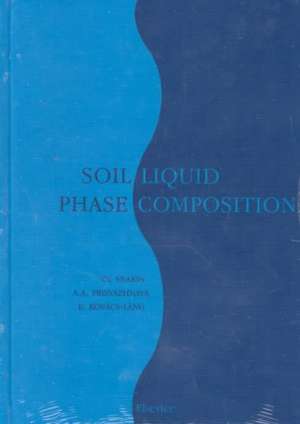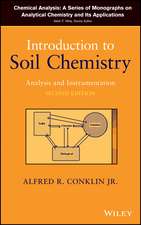Soil Liquid Phase Composition
Editat de V.V. Snakin, A.A. Prisyazhnaya, E. Kovács-Lángen Limba Engleză Hardback – 20 mai 2001
This volume sums up the vast experience of the authors' research into soil liquid phase composition in various ecosystems of Central and Eastern Europe. It describes the methodological basics of soil liquid phase research: methods of soil solution extraction, the main problems of application of ion-selective electrodes for immediate in situ assessment of ionic activity in soil liquid phase and redox potential, and ways to overcome those problems. Data are presented on soil liquid phase composition in natural and agricultural ecosystems, their redox, pH, carbonate and other regimes as well as the relations between the composition of the soil liquid phase and different ecological properties.
This work is devoted to the pursuit of new approaches to soil liquid phase analysis with a goal of discovering the role of soil liquid phase in the functioning of natural and agricultural ecosystems in recent soil-formation, formation of primary biological production, and in bio-geochemical turnover of elements. It includes new field investigation data as well as all data generalization carried out by means of a special complex database (developed by the authors) on soil liquid phase composition and other soil-ecological properties in various ecosystems in Central and Eastern Europe.
This book is the first English edition that integrally considers both methodological aspects and results of investigation of composition, formation, dynamics, spatial heterogeneity, and interrelations of soil liquid phase with other components of ecosystems. Soil scientists, agricultural chemists and ecologists will find this title of great interest.
Preț: 1181.45 lei
Preț vechi: 1618.42 lei
-27% Nou
Puncte Express: 1772
Preț estimativ în valută:
226.08€ • 241.75$ • 188.49£
226.08€ • 241.75$ • 188.49£
Carte tipărită la comandă
Livrare economică 18 aprilie-02 mai
Preluare comenzi: 021 569.72.76
Specificații
ISBN-13: 9780444506757
ISBN-10: 0444506756
Pagini: 319
Ilustrații: 1
Dimensiuni: 156 x 234 x 19 mm
Greutate: 0.63 kg
Editura: ELSEVIER SCIENCE
ISBN-10: 0444506756
Pagini: 319
Ilustrații: 1
Dimensiuni: 156 x 234 x 19 mm
Greutate: 0.63 kg
Editura: ELSEVIER SCIENCE
Cuprins
Introduction.
Acknowledgments.
Chapter 1. Soil Liquid Phase As A Structural Element Of An Ecosystem.
Types of soil water. Pellicular water. Capillary water. Gravitational water. Soil liquid phase in environmental research. Chapter 2. Soil Liquid Phase Investigation. Methods of soil solutions extraction. Ionometric analysis of soil samples. Activity and concentration of ions. ISE selectivity coefficients. The influence of solid phase on ionometric measurements in soil. Influence of the gas phase on the ionometric measurements in soil (incomplete contact between the electrode and soil). In situmeasurements of ionic activity in soil. Compensation of temperature dependence in ion-selective systems. The selection of electrodes. Getting the electrodes set for work. The process of measurements in soil. Measurement of the soil redox potential. Comparison of different methods of soil liquid phase investigation. Laboratory methods. In situ measurements and displaced soil solutions. Soil solution, soil and plant analytical methods. Data base. Conclusions. Chapter 3. Study Areas. The environment. Climate. Vegetation. Soils. Chapter 4. Environmental Impact On The Soil Liquid Phase. Soil solid phase. Atmosphere and soil air. Hydrological regime. Temperature. Vegetation. Atmospheric precipitation and forest vegetation. Ecosystems and soil types. Anthropogenic factors. Field management and soil liquid phase composition. Soil resistance to acid rain. Soil liquid phase under recultivation. Conclusions. Chapter 5. Spatial And Temporal Properties Of Soil Liquid Phase. The composition of soil liquid phase. Soil redox potential (Eh). pH properties. Calcium activity. Potassium activity. Nitrate activity. Spatial heterogeneity. Temporal variability. The estimation of the necessary number of collected data for the reliable determination of soil characteristics. Dynamics of the soil liquid phase. Sandy semi-desert steppe. The Middle Danube steppe. The Priazov steppe. The Colchid forest. Conclusions. Chapter 6. Material And Energy Exchange In Ecosystems. Soil carbonate equilibrium. Assessment of carbon equilibrium status. Atmospheric CO2 and soil liquid phase. Soil liquid phase oxidation and pH as indices of ecosystem functioning. Oxidation-reduction in soils. The Eh-pH graph. Soil redox regime and grassland productivity. Thermodynamic interpretation of Eh changes. In vivo Eh measurements in animals. Potassium dynamics in the soil liquid phase. Potassium and nitrate in the liquid phase of agricultural soils. Silicon in soil solutions. Organic matter in soil solutions. Heavy metals. Correlation between soil solid and liquid phases composition. Conclusions. Chapter 7. Environmental Processes And Soil Liquid Phase. Photosynthetic intensity. Transpiration and evaporation. Plant matter dynamic. Ecological assessment of the degree of anthropogenic changes in soil. Soil liquid phase and ecosystem contamination. Conclusions. Summary. Glossary. References. Correlation Between Soil Names. Subject Index. Author Index.
Acknowledgments.
Chapter 1. Soil Liquid Phase As A Structural Element Of An Ecosystem.
Types of soil water. Pellicular water. Capillary water. Gravitational water. Soil liquid phase in environmental research. Chapter 2. Soil Liquid Phase Investigation. Methods of soil solutions extraction. Ionometric analysis of soil samples. Activity and concentration of ions. ISE selectivity coefficients. The influence of solid phase on ionometric measurements in soil. Influence of the gas phase on the ionometric measurements in soil (incomplete contact between the electrode and soil). In situmeasurements of ionic activity in soil. Compensation of temperature dependence in ion-selective systems. The selection of electrodes. Getting the electrodes set for work. The process of measurements in soil. Measurement of the soil redox potential. Comparison of different methods of soil liquid phase investigation. Laboratory methods. In situ measurements and displaced soil solutions. Soil solution, soil and plant analytical methods. Data base. Conclusions. Chapter 3. Study Areas. The environment. Climate. Vegetation. Soils. Chapter 4. Environmental Impact On The Soil Liquid Phase. Soil solid phase. Atmosphere and soil air. Hydrological regime. Temperature. Vegetation. Atmospheric precipitation and forest vegetation. Ecosystems and soil types. Anthropogenic factors. Field management and soil liquid phase composition. Soil resistance to acid rain. Soil liquid phase under recultivation. Conclusions. Chapter 5. Spatial And Temporal Properties Of Soil Liquid Phase. The composition of soil liquid phase. Soil redox potential (Eh). pH properties. Calcium activity. Potassium activity. Nitrate activity. Spatial heterogeneity. Temporal variability. The estimation of the necessary number of collected data for the reliable determination of soil characteristics. Dynamics of the soil liquid phase. Sandy semi-desert steppe. The Middle Danube steppe. The Priazov steppe. The Colchid forest. Conclusions. Chapter 6. Material And Energy Exchange In Ecosystems. Soil carbonate equilibrium. Assessment of carbon equilibrium status. Atmospheric CO2 and soil liquid phase. Soil liquid phase oxidation and pH as indices of ecosystem functioning. Oxidation-reduction in soils. The Eh-pH graph. Soil redox regime and grassland productivity. Thermodynamic interpretation of Eh changes. In vivo Eh measurements in animals. Potassium dynamics in the soil liquid phase. Potassium and nitrate in the liquid phase of agricultural soils. Silicon in soil solutions. Organic matter in soil solutions. Heavy metals. Correlation between soil solid and liquid phases composition. Conclusions. Chapter 7. Environmental Processes And Soil Liquid Phase. Photosynthetic intensity. Transpiration and evaporation. Plant matter dynamic. Ecological assessment of the degree of anthropogenic changes in soil. Soil liquid phase and ecosystem contamination. Conclusions. Summary. Glossary. References. Correlation Between Soil Names. Subject Index. Author Index.
Recenzii
from: D.E. Rolston
"...it should be useful as a reference source for soil solution chemists and potentially other researchers interested in the soil liquid phase. " --Soil Science
"...it should be useful as a reference source for soil solution chemists and potentially other researchers interested in the soil liquid phase. " --Soil Science









